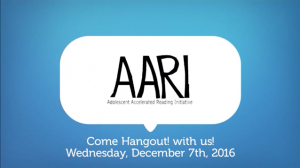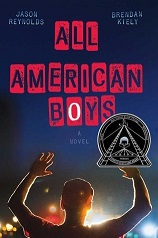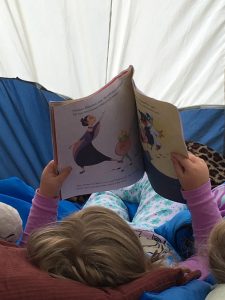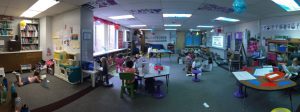 The best professional development has to inspire me, engage me, and challenge me to try something new. Some of my favorite conferences have been MACUL and NCTE; I always leave feeling exhausted from attending so many amazing sessions, overwhelmed with all of the great resources I’ve been introduced to, and excited to try something new with students the next day, back in my classroom.
The best professional development has to inspire me, engage me, and challenge me to try something new. Some of my favorite conferences have been MACUL and NCTE; I always leave feeling exhausted from attending so many amazing sessions, overwhelmed with all of the great resources I’ve been introduced to, and excited to try something new with students the next day, back in my classroom.
But I can’t always attend the conferences, due to location or funding. So I’ve had to get creative with ways to provide comparable experiences in my professional life. Here are four virtual professional development ideas that have energized my teaching.
- Use Twitter Hashtags.
I hope you are on Twitter. If you find the right hashtags, you can learn a lot about the things that matter to you as an educator. Want to learn more about using technology in your classroom? Search #CEL16 or #4TDW and get lost in the conversations, links, images, and resources. Teach English? Search #NCTE16 or #EngChat. Once you start searching, you can find people that you might want to follow, based on their tweets. If you are attending a conference, you might start tweeting with a hashtag and follow likeminded colleagues from different places. And if you can’t attend a conference (like the recent NCTE conference), you can still benefit from the learning and thinking that took place because of hashtags. - Attend a Webinar.
This past October, I was a moderator for the 4TDW conference on digital writing. As my partner and I were creating his session on using collaborative digital writing, I learned a lot about what goes into creating an effective, engaging webinar. Much thought is put into creating a virtual space that fosters participation, focuses your learning in a short time, and pushes your thinking (many times you are able to gain SCECHs too). Even if you can’t attend a live webinar, usually you can watch the recorded webinar on your own timetable. Oakland Schools has a great series on vocabulary, word study, and grammar that you can still register for. Best of all, these types of professional learning are usually FREE! - Sign up for an Online Course in miPLACE.
One of my new job responsibilities has been to help create engaging, online professional development for teachers who support struggling readers. There are a ton of great modules created by teachers and teacher consultants in Oakland School’s virtual community, MiPlace. If you haven’t been there to check them out yet, now is the time! Once you create an account or log in, you can browse or search the Course Catalogue under the Hub tab.  Come Hangout!
Come Hangout!
If you teach AARI, you can attend our next “Come Hangout!” on December 7th. We use Adobe Connect to talk about relevant topics virtually, and from the comfort of your own home, you can have an experience like an after-school meeting. We had a great discussion about student engagement in September and created a resource document around our thinking. Still, you don’t need a special platform like Adobe Connect to meet up virtually with colleagues. You can create a Google Hangout or shared Google Doc with a group of colleagues from your building or beyond (maybe someone you follow on Twitter?!) around a topic you are interested in discussing. It is rejuvenating and validating to talk with other teachers around shared topics to help each other, push each other, celebrate, and learn.
When you take control of your virtual professional learning, and make use of technology to fit it into your life, you can really enhance your teaching practice to benefit you and your students.
 Caroline Thompson (@TeacherThompson) taught middle school ELA for twelve years in Lake Orion before becoming a stay-at-home mom. She supports AARI teachers for Oakland Schools as an independent literacy consultant in the areas of digital media, professional development, and non-fiction resources. Caroline is a Reading and Writing Workshop advocate, a 2008 Oakland Writing Project Teacher Consultant, and a 2009 Oakland County Outstanding Teacher of the Year Nominee. She has a BA in English from Michigan State University and a Masters in the Art of Teaching Reading from Oakland University. She lives in Berkley, Michigan with her husband and their three year old daughter.
Caroline Thompson (@TeacherThompson) taught middle school ELA for twelve years in Lake Orion before becoming a stay-at-home mom. She supports AARI teachers for Oakland Schools as an independent literacy consultant in the areas of digital media, professional development, and non-fiction resources. Caroline is a Reading and Writing Workshop advocate, a 2008 Oakland Writing Project Teacher Consultant, and a 2009 Oakland County Outstanding Teacher of the Year Nominee. She has a BA in English from Michigan State University and a Masters in the Art of Teaching Reading from Oakland University. She lives in Berkley, Michigan with her husband and their three year old daughter.

 So it’s November, and it may seem odd to see the title “early choice” in a blog post. It’s not early in the year, and yet for an elementary teacher whose students are blogging, it is.
So it’s November, and it may seem odd to see the title “early choice” in a blog post. It’s not early in the year, and yet for an elementary teacher whose students are blogging, it is. Beth Rogers is a fifth grade teacher for
Beth Rogers is a fifth grade teacher for  I recently read a knock-out YA novel. It happens to be one of the choices for the
I recently read a knock-out YA novel. It happens to be one of the choices for the 
 A few weeks ago I wrote about
A few weeks ago I wrote about  Hattie Maguire (
Hattie Maguire ( Our annual return-to-school professional development this year was a lovely buffet of technology-themed mini-workshops to help us navigate the ever-expanding realm of ed tech. The PD was well received, and it also got me thinking.
Our annual return-to-school professional development this year was a lovely buffet of technology-themed mini-workshops to help us navigate the ever-expanding realm of ed tech. The PD was well received, and it also got me thinking.  Enter “
Enter “
 My daughter, Taylor, just started her first grade year. She left kindergarten at grade level in reading, and at the end of the year, she was just starting to believe in herself as a reader.
My daughter, Taylor, just started her first grade year. She left kindergarten at grade level in reading, and at the end of the year, she was just starting to believe in herself as a reader. Since this can-read attitude is a goal for my own kindergarteners, I’ve already started thinking about how to maximize this mindset for them when summer arrives. Yes, I know we’ve just started school, but the thought is fresh in my mind and the problem is a big one!
Since this can-read attitude is a goal for my own kindergarteners, I’ve already started thinking about how to maximize this mindset for them when summer arrives. Yes, I know we’ve just started school, but the thought is fresh in my mind and the problem is a big one! Tricia Ziegler (Twitter:
Tricia Ziegler (Twitter: